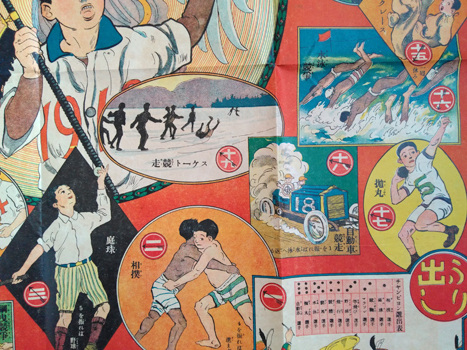
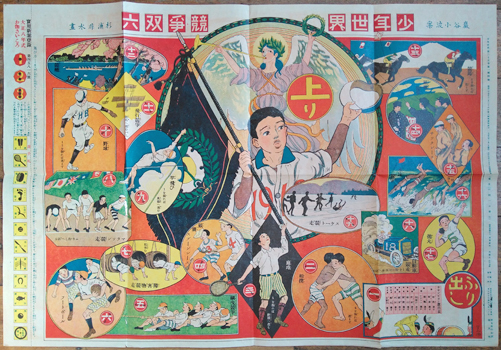
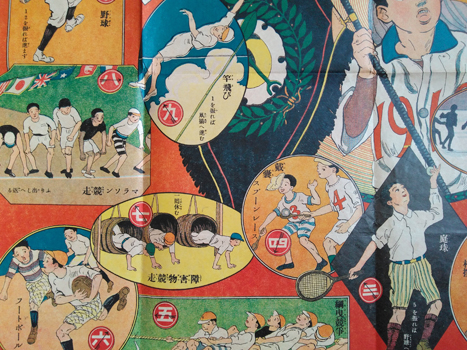
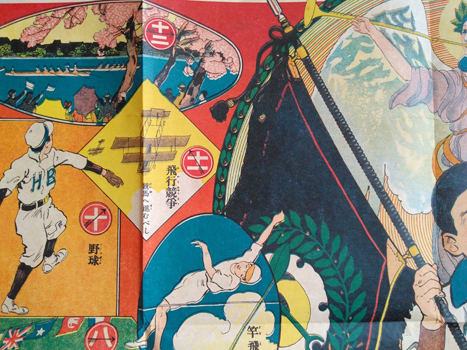

Sugiura Hisui. [Shonen Sekai Kyoso Sugoroku]. Tokyo, Shonen Sekai 1919 (Taisho 8). Colour broadside 54x78cm. A couple of small nicks in a margin; rather good with playing pieces intact in the left margin. Au$400
Sports, sports and more sports in this game - the new year gift from the boys' magazine Shonen Sekai. If you look at portraits of the champion of modern design and fastidious dandy, Sugiura, it's hard to imagine anyone less inclined to jump and sweat. But maybe I misjudge him.

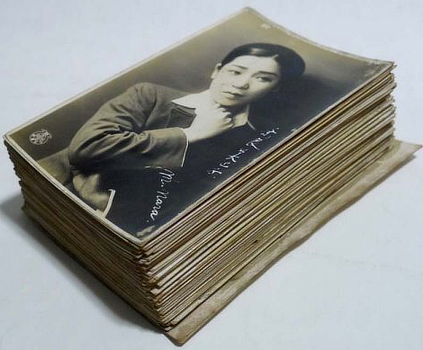
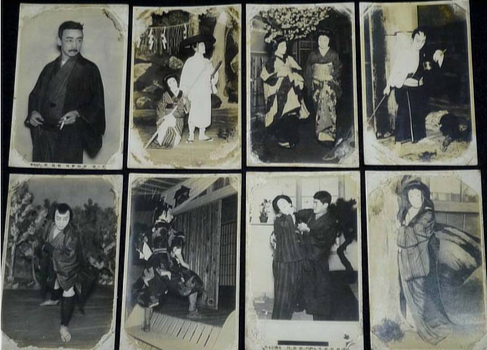
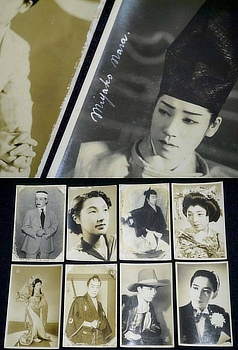

Takarazuka. A collection of 112 bromide photo postcards of Takarazuka actors n.p. c1920 to 30. These were obviously in an album with corners which have somehow interacted with the photo surface and caused bleaching and marks to corners and edges. There are three or four plain photos, the rest are postcards. Four have writing on the back and three are stamped. These are dated 1920. Au$500
The Takarazuka, the all women theatre company, was founded in 1913, presented their first show in 1914, introduced the revue to Japan in 1927, and is now, as much of the world knows, huge. There is a mountain of stuff out there but there is a paucity of images and information from their first years. A collection like this - the number of postcard photos - makes it evident that there was a well established fandom and a fair industry in satisfying them by the twenties, but not so much seems to have survived.
Sketchy and gap-toothed lists of actors are extant but most have no accompanying portraits; similarly sketchy lists of productions survive but even fewer are accompanied by photographs. I went through a decade of actors grouped by their first year assiduously collected on Takawiki expecting to find several examples of the same cards; I found one.
In later years actors became specialists, the otokoyaku play men, the musumeyaku play women, but our actors played men and women, Japanese and westerner, traditional and modern, gangster and empress. Nara Miyako, Kadota Ashiko and Ashihara Kuniko are identified; the rest are up to you. All are in costume and most are in action on stage.
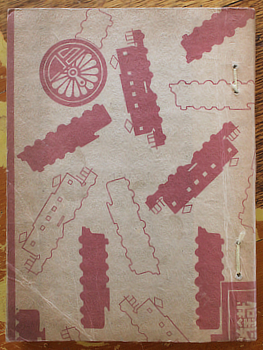
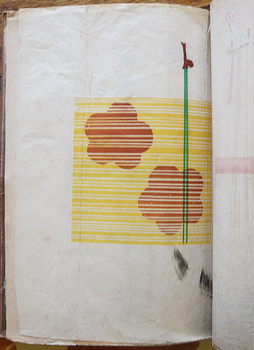
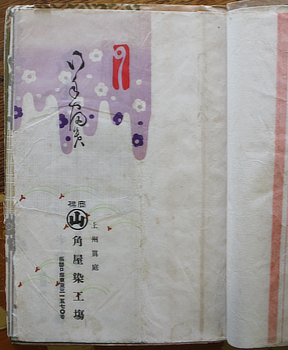
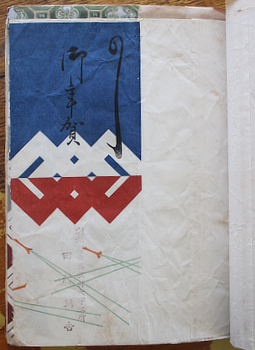

Noshigami. A sample book of Noshigami - special paper for gifts - from the Kadoya Dyeing Workshop, Tokyo. Tokyo [1920s?]. 24x18cm, home made printed stiff wrappers; 105 leaves of colour printed samples on different kinds of paper, various sizes. Au$400
Noshi-gami is specially printed paper to be folded and attached to gifts as I understand it. The ineluctable beauty of some patterns is enhancedher, I say, by being in a quite smart cover decorated with locomotives.
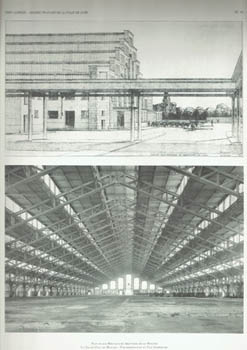
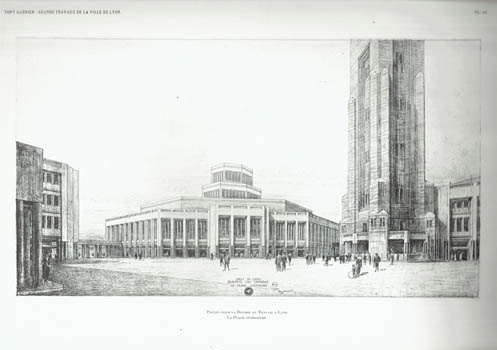

GARNIER, Tony. Les Grands Travaux de la Ville de Lyon. Etudes, projets et travaux executes. Paris, Massin [1920]. folio, loose as issued in publisher's portfolio of cloth backed printed boards; 12pp and 56 plates - drawings, plans, elevations and photos. Au$1200
In Garnier's work in Lyon, instigated by the mayor Edouard Herriott from 1906 on, he realised many of the ideas set forth in his Cite Industrielle and some of the ideas in Cite Industrielle came from his work in Lyon. Une Cite Industrielle was largely finished by 1904 but not published until 1918 so he had the chance to plug a few of the gaps in his imagined city from his real city. Some projects here were completed in later years and some never realised.
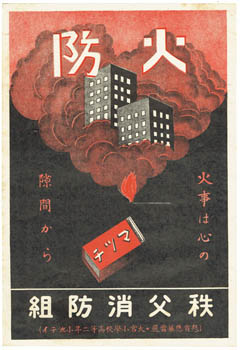
Fire Safety Poster. - [Hifuse - Chichibu Shobogume]. Chichibu Fire Prevention Publicity Department [192-?]. Colour litho poster 39x27cm. Au$225
A good straightforward illustration of what a carefully applied match can do.
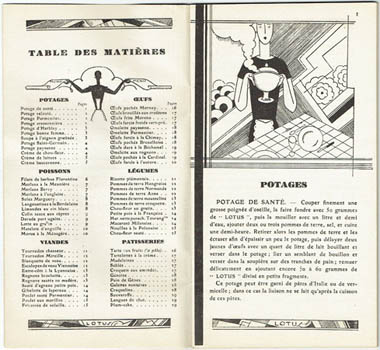
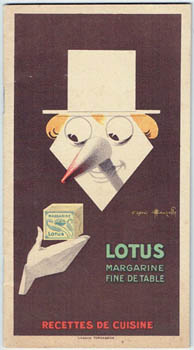
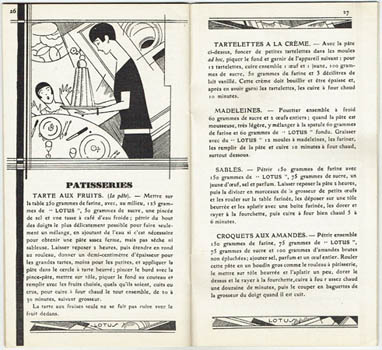

Advertising - Lotus Margarine. Lotus Margarine. Fine de Table. Recettes de Cuisine. Lotus [192-?]. 21x11cm publisher's colour illustrated wrapper; 32pp, b/w illustrations and decorations throughout. Cover (and inside?) by Duzolle. Au$85
A nifty little booklet, packed with style and cordon bleu recipes.
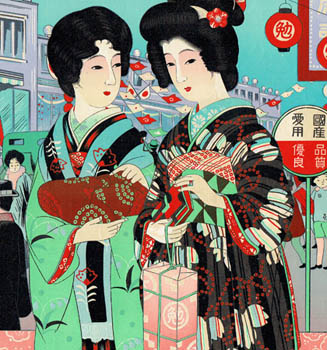
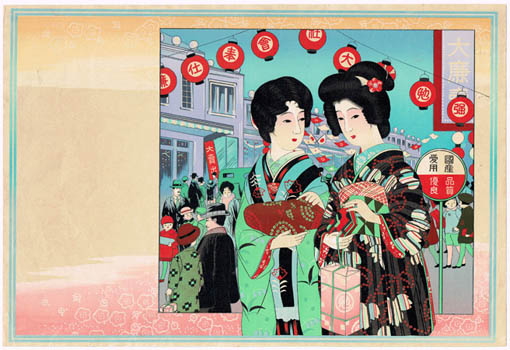

Hikifuda. Specimen hikifuda. n.p. [192-?]. Colour lithograph 26x38cm. A bit creased, stab holes on the right indicating it was once in an album. A printed code number on the back. Au$135
A glamorous pair of Taisho women doing what urban Japanese did best: throng the busy exciting streets and shop. These hikifuda - handbills or small advertising posters - were often produced with blank frames for customers to have their own wares and business details printed over. I'd guess this was aimed at the fashion industry.
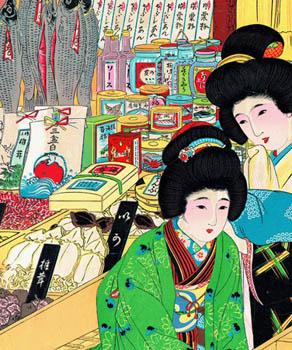
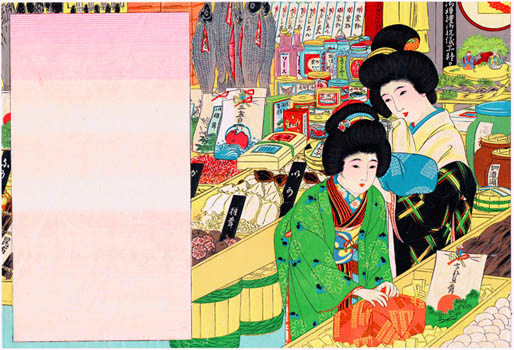

Hikifuda. Specimen hikifuda. n.p. [192-?]. Colour lithograph 26x38cm. A bit rumpled, stab holes on the right indicating it was once in an album. A printed code number on the back. Au$150
The vivid and exciting world of groceries beautifully depicted. These hikifuda - handbills or small advertising posters - were often produced with blank frames for customers to have their own wares and business details printed over.
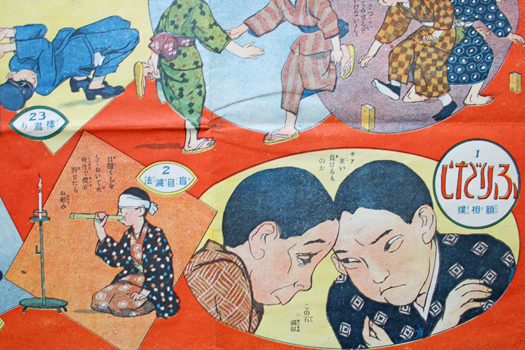
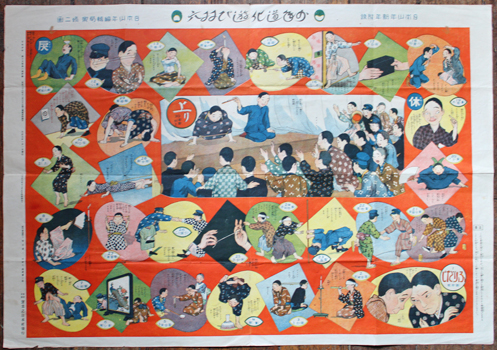
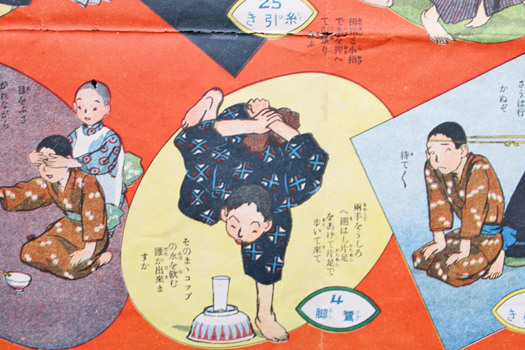
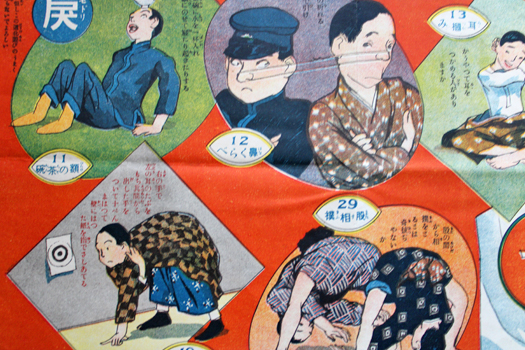

Nakano Shuji. [ ?] [Kao?] [Doke Asobi Sugoroku]. Tokyo, Nihon Shonen 1920 (Taisho 9). 55x79cm colour broadside. Signs of use: some brown spots, small holes in folds. Au$150
I'm baffled by the first two characters in the title. I find that most references transcribe them as 日本 (Nihon - Japan) or 少年 (shonen - boy) and I don't know why, since that's the source, not the title. Only one gives us かお (Kao - face) which bears some resemblance to the actual characters but really doesn't seem satisfactory.
Anyway, this a game of boys' games - games that involve physical antics and clowning such as forehead wrestling - and was the new year gift from the magazine Nihon Shonen and you know how that translates if you've been paying attention.
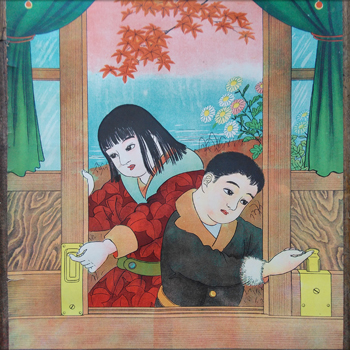
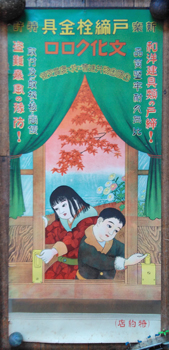
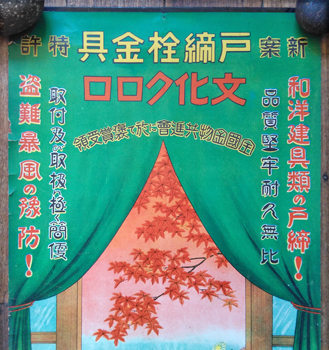
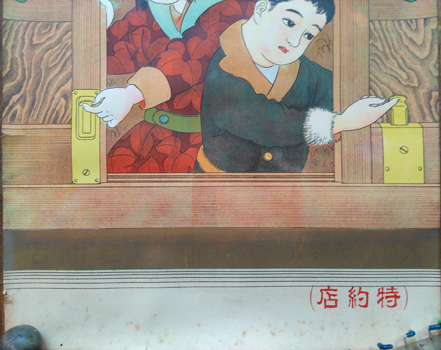

[Tojimari Sen Kanagu : Bunka Kuroro]. [192-?]. Colour lithograph poster 76x35cm. Short tears around the edges; pretty good. Au$200
This shop poster is both an advertisement and a warning: these handsome door or window locks will not keep out mournful children.
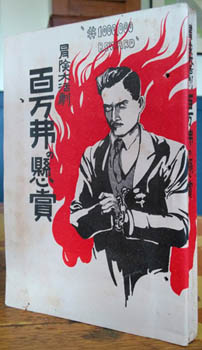
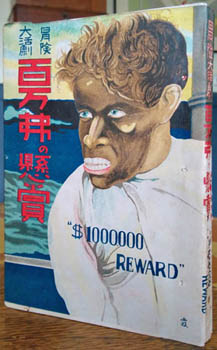
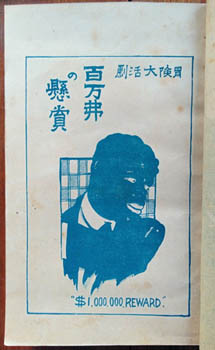
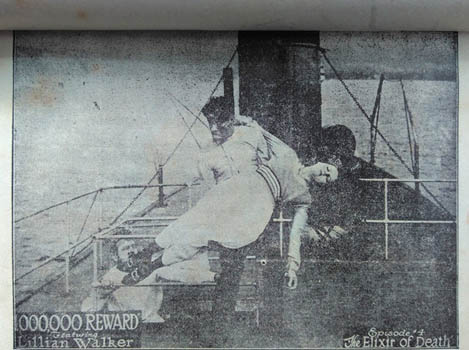

$1000000 Reward [Hyakumandoru no Kensho]. Tokyo, Shunkodo 1920 (Taisho 1920). Octavo publisher's illustrated wrapper printed in red and black and colour illustrated dustwrapper (the spine of this insect nibbled); two photo plates and illustrated title. Stab holes indicating this had been in some outer binding; natural browning of the paper; an outstanding copy. An owner's seal and brushed inscription inside the front cover and on the back cover suggests this is some kind of file copy. Au$475
A pulpish film edition in Japanese translation of the 1920 serial thriller $1,000,000 Reward starring Lillian Walker. The film itself is lost and from what I can figure out not much more than production credits and a partial list of chapter headings survives in English. This book is near as lost, I can find only one record of another copy - not in a library.
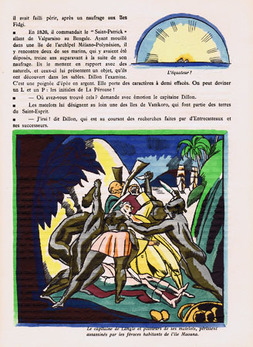
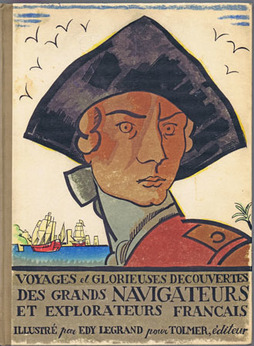

LEGRAND, Edy. Voyages Glorieuses Decouvertes des Grands Navigateurs & Explorateurs Francais. Paris, Tolmer 1921. folio publisher's illustrated boards & cloth spine; 2 folding maps & illustrations throughout coloured by pochoir. A rather good copy in a cloth chemise and slipcase. Au$750
One of the triumphs of modern French book making which, fittingly enough looks back to the triumphs (or glory at least) of Cartier, de la Salle and La Perouse.
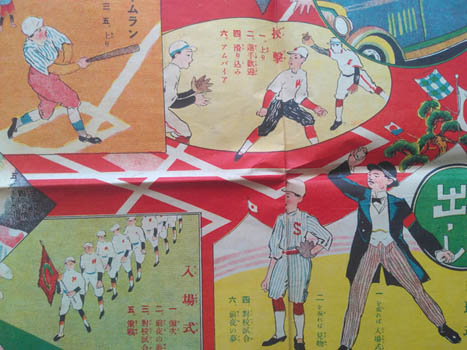
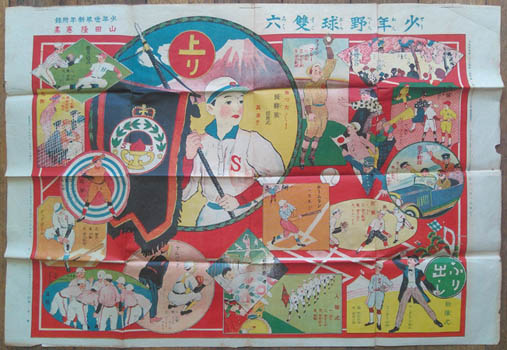
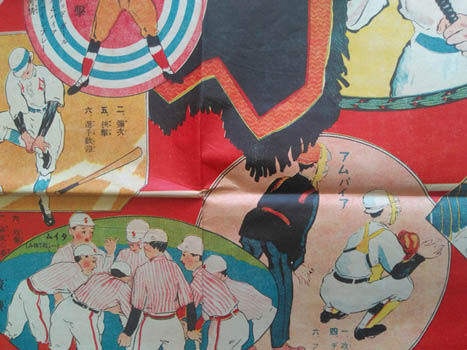


Yamada Takanori. [Shonen Yakyu Sugoroku]. Tokyo, Shonen Sekai 1921 (Taisho 10). Colour broadside 55x79cm. Used, a bit rumpled and browned with some short tears and a small chip in the margin. This is - some mitigation - an untrimmed copy with ample margins and trim marks in the top margin. Not bad. Au$500
An early and rare baseball sugoroku, this was the new year gift from the boys' magazine Shonen Sekai. There is an earlier Japanese baseball paper game (新案 室内ベースボール 1907) but it's not exciting - a simple baseball diamond within a decorative border - and I haven't yet found an earlier sugoroku devoted to it.
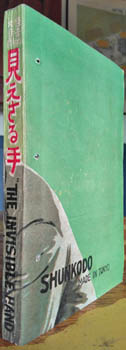
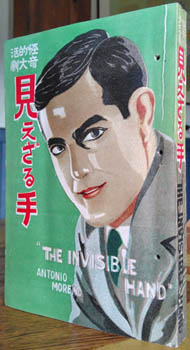
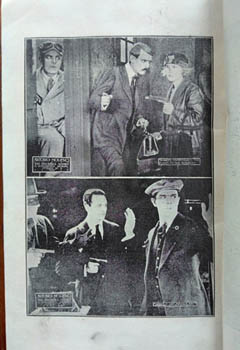

[Miezaru Te] The Invisible Hand. Tokyo, Shunkodo 1921 (Taisho 10). Octavo publisher's colour colour illustrated wrapper; four photo illustrations on two plates. Stab holes indicating this had been in some outer binding; natural browning of the paper; an outstanding copy. Au$400
A pulpish film edition in Japanese translation of the 1920 Vitagraph serial thriller The Invisible Hand starring the then Latin idol Antonio Moreno. The serial was not, despite what some authorities will tell you, a western. The film itself is lost and from what I can figure out not much more than production credits and a list of chapter headings survives in English. This book is near as lost, I can't find any record of another copy.
By the mid fifties Moreno was a support in Creature from the Black Lagoon and an Indian chief in Saskatchewan.
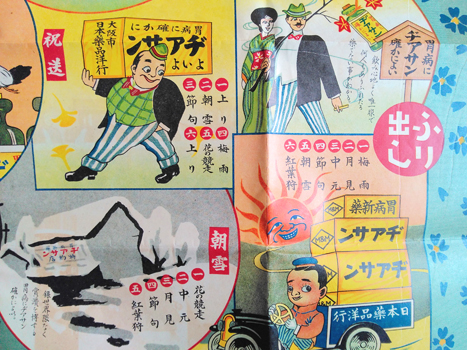
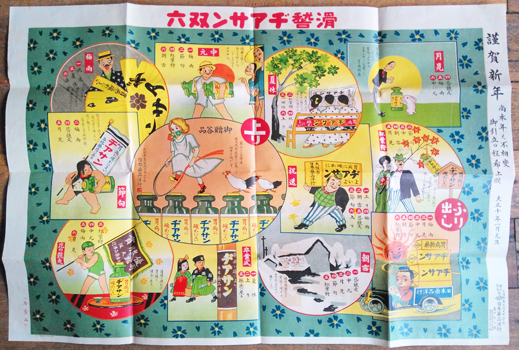
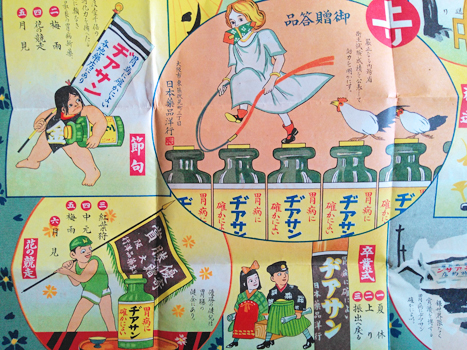
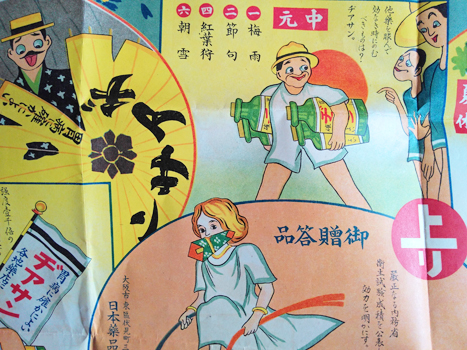

Sugoroku. [Diasan Sugoroku]. Osaka, Morishita 1921 (Taisho 10) Colour broadside 54x78cm. A nice copy. Au$450
A rare and cheerful promotional game for New Year from a friendly drug company. I don't know exactly what Diasan did - it was some kind of digestive - but it clearly made you healthy and happy.
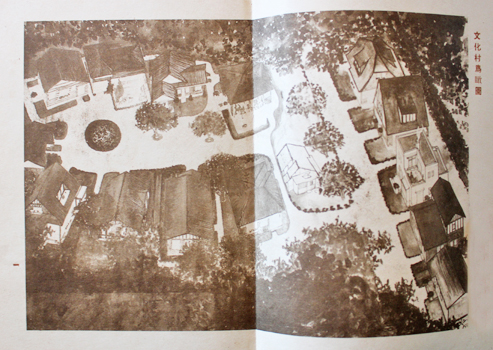
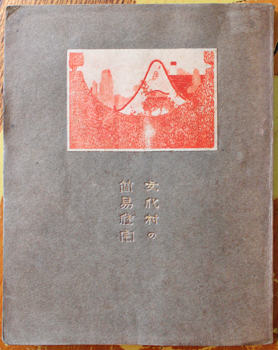
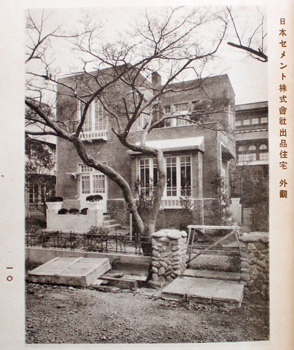
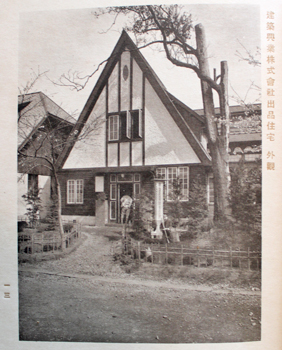

Takanashi Yoshitaro [ed]. [Bunkamura no Kan'i Jutaku]. Tokyo, Koyosha 1922 (Taisho 11). 19x15cm, publisher's stiff wrapper with mounted illustration; title, 19pp of text and 54 plates printed on one side: photo illustrations, floor plans and renderings, one double page. Some marks and minor signs of use. Au$300
Fourth printing, two months after the first, of this architectural guide to Japan's model Culture Village (Bunkamura) of 'simple' housing built for the 1922 Peace Exposition; the purposeful introduction of idealistic westernised homes, rather than mansions and commercial buildings. Western mostly on the outside, not so much inside. Fourteen houses were built by different builders that had to meet 15 guidelines which did not stipulate that the outside had to be western but did demand windows rather than shutters and paper screens and that decoration should be avoided. Living spaces had to be chair style and kitchens and bathrooms thoroughly up to date. After that it was up to the designers and builders and the results are what's usually called ecleticism, hybrid, or borrowing, but isn't so simple in intent. And, as usual, what was borrowed from the west was often a reclamation of what the west had borrowed from Japan: arts & crafts in England, craftsman in America, nouveau, seccesion, werkstatte, and whatever else in Europe.
At much the same time as this, across town another Bunkamura - the Mejiro Bunkamura development by Tsutsumi Yasujiro - was being launched, reportedly inspired by the streetscape of Beverly Hills. The houses in both villages were for the new middle classes but Tsutsumi's village was for the upper middle class. Much of what was built during the twenties was destroyed during the war but the remaining fragments show shared characteristics which I'd say, from the bit I've read about him, had nothing to with any idealism in Tsutsumi.
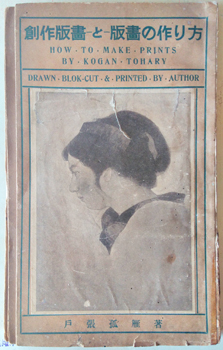
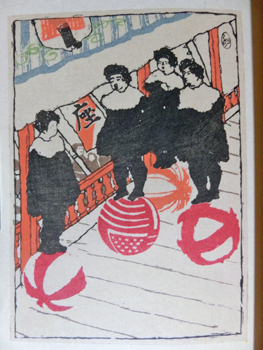
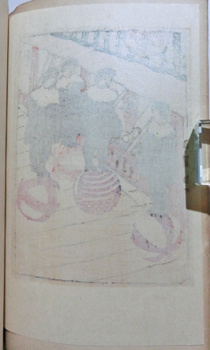
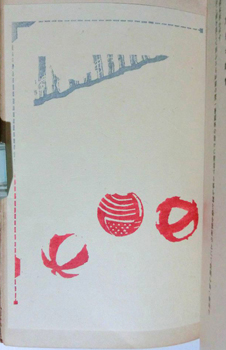

Tobari Kogan. [Sosaku Hanga to Hanga no Tsukurikata] How to Make Prints by Kogan Tohari : Drawn, blok-cut & printed by author [sic]. Tokyo, Hangasha 1922 (Taisho 11). 21x14cm publisher's printed card wrapper with mounted illustration (wear to spine with an old tape mark, stain on the back, other signs of use); 10 mounted b/w photo illustrations, one b/w illustration and six mounted woodcuts, being three blocks with five colours, the key block in black, the complete print all in black, and the finished colour print. A somewhat dishevelled cover but not bad; mild browning, all rather good and fresh inside. The wrappers look like they have been cut back from the page edges but they are folded and that's how the book was issued. Au$2500
An idiosyncratic book printed on tan stiff card which, while browned, is not as browned as it might appear in photos. The prints themselves are crisp and bright. The half-tone illustrations do Tobari's work no favours but I guess they gave some vague indication of his work. He produced so few prints that more than half of them are here.
Tobari has made for this lesson a smaller version of his mysterious print of acrobats: is it political commentary? religious? all just show biz? He was a founding member of the sosaku hanga - creative prints - movement which cut all and any middle men between the artist and final print. I'm embarrassed to admit that I knew nothing of him until recently when I watched three of his prints that I admired and coveted - one of them the acrobats - sell for a few tens of thousands of dollars. So I have learnt that he is hardly a well kept secret but I haven't learnt much about him except that he studied and caught TB in America and was established as a Rodinesque sculptor before turning to print making and that he died youngish, in 1927. He didn't have time to become a grand old man of art like his colleagues Koshiro Onchi, Maekawa Senpan and Kawakami Sumio. Onchi was dismissive of, almost venomous about, Tobari in his 1953 book on modern prints. Tobari was too technically skilled and too emotional and Onchi, for all his achievement, could not produce the exquisite and moving portrait represented by the grey blur on the cover of this book.
This is pretty rare; Worldcat finds only the V&A and BL entries outside Japan.
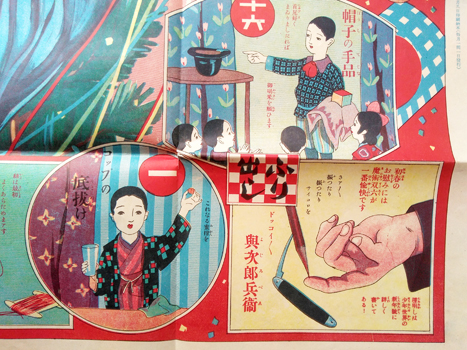
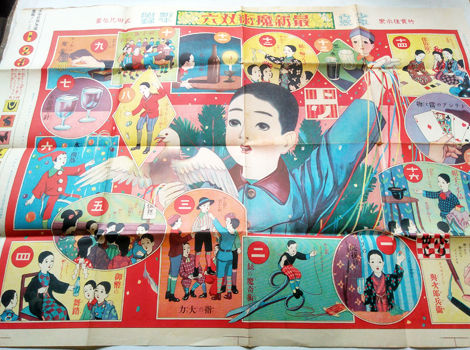
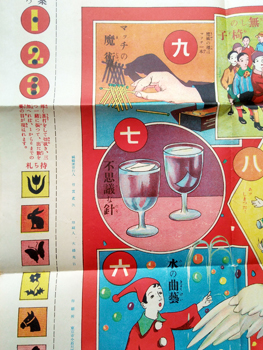
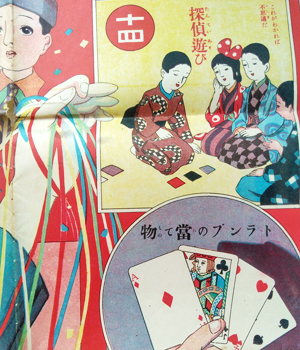

Takeda Hisa. [Saishin Majutsu Sugoroku]. Tokyo, Shonen Sekai 1922 (Taisho 11). 55x80cm colour broadside. Some small holes in folds; with the playing pieces intact in the margin plus the new year issue of Shonen Sekai that this game came with (spine separating but all there and decent enough). Au$300
This game of the latest in magic was the new year gift for 1922 readers.

Catalogue - Fashion. Ribby. Paris. Ribby 1923 - 1924. Paris 1923. Largish octavo printed wrapper (dusty and a bit marked); 16pp, illustrated throughout, the first page colour. A bit used but very decent. Au$80
Smart autumn and winter outfits for men and women, casual and formal.
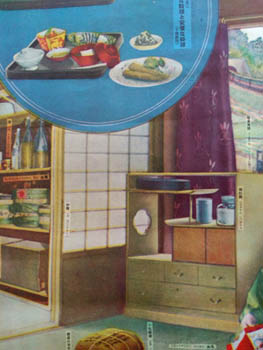
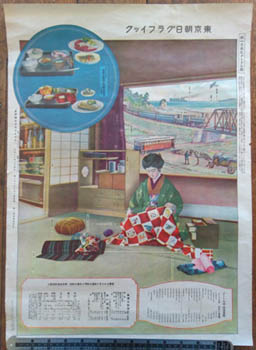
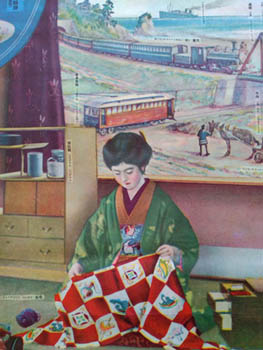

Metrication. [Toitsu Sa Reta Metoru-ho]. Tokyo, Asahi Graphic 1923 (Taisho 12). Colour poster 53x38cm. Au$90
Handy educational tool for the imminent establishment of the metric system as Japan's official system of measurement. Up until then metric, imperial and traditional measures were legal. It was proposed to make a gradual change over ten years but by the thirties the nationalistic backlash meant that it was all postponed again. And again. The American occupation forces cared nothing for metrics and it was the mid sixties before everybody was up to scratch.
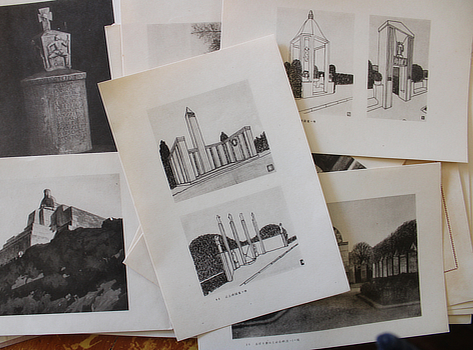
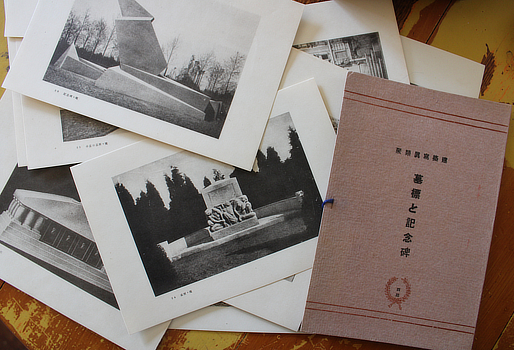
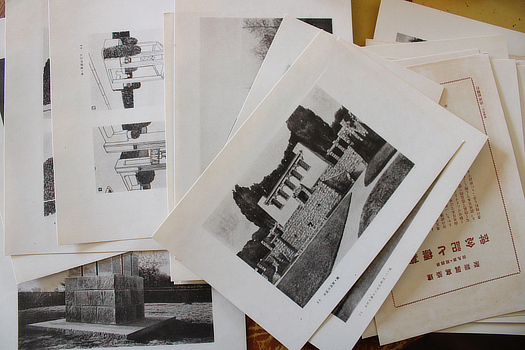
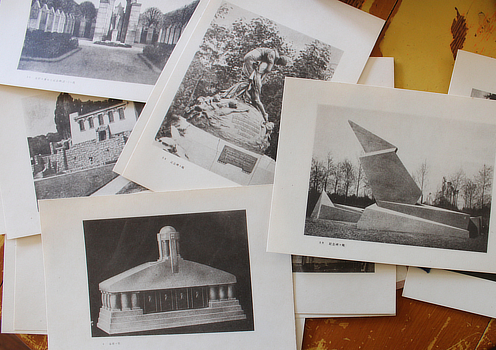

[Bohyo to Kinenhi]. Tokyo, Koyosha 1923 (Taisho 12). 19x13cm, loose as issued in publisher's printed boards; 50 leaves, mostly plates printed on one side. An excellent copy. Au$100
One of the apparently endless series of small architecture monographs, Kenchiku Shashin Riuju. I wonder if anyone knows how many there were. Some are intriguing and some are pretty drab. Many require a dogged love of gateways and tea rooms. This one is pretty good.
Gravestones and memorials, a good mix of old school kitsch and moderne, a few to the edge of extreme. They can be examples of pure design, being free and limitless, as the foreword says, and here are offered as a lesson to Japanese to reform their gloomy and sad approach to marking their dead in the landscape.
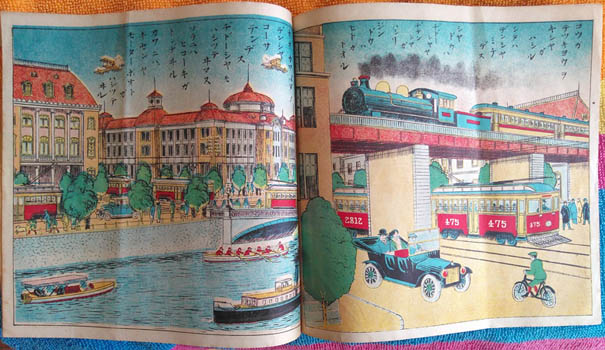
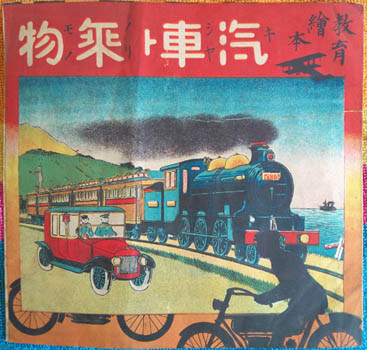
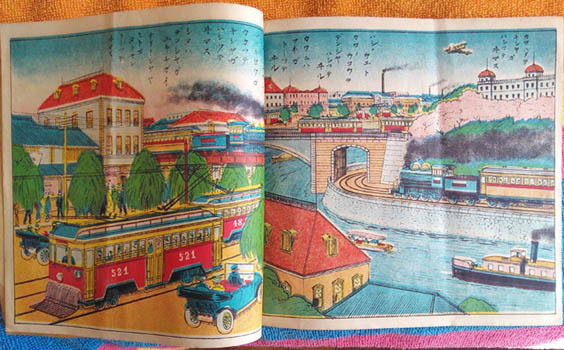

[Kisha to Norimono]. Osaka, Okamoto Zoshindo 1923 (Taisho 12). 17x18cm publisher's colour illustrated wrapper; [12]pp including wrapper, eight full page illustrations inside. The back wrapper - which is flimsier paper - is browned and creased; a pretty good copy. Au$150
Machines and people on the move - what better subject for a book? Better quality than the really cheap akahon (red books) for kids that came out of Osaka but not a lot.
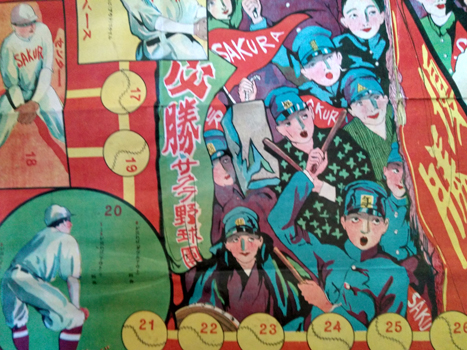

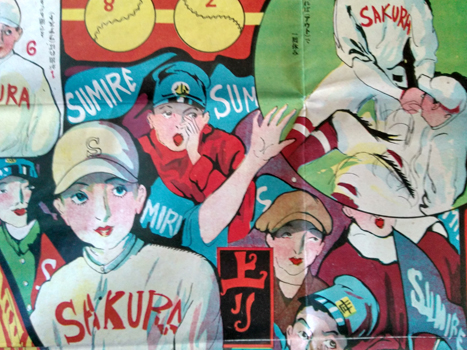
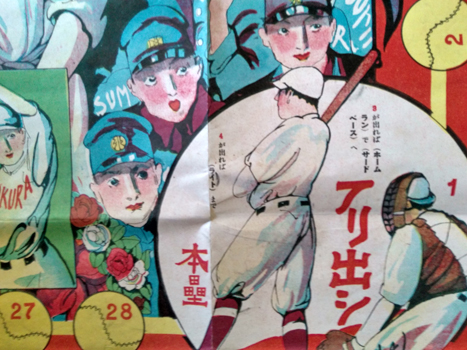

Morita Hisashi. [Kensho Tsuki Shonen Yakyu Sugoroku]. Tokyo, Sekai Shonen 1923 (Taisho 12). Colour broadside 55x79cm. Signs of use: a couple of small holes in folds and ink blotches. Au$350
An early baseball game. Baseball made cameo appearances in earlier games devoted to sport but the earliest all baseball sugoroku I've so far seen was the 1921 new year sugoroku also produced by the boy's magazine Shonen Sekai. Clearly it was a hit - this was the new year gift only two years later.
Morita was a busy illustrator and art director for the Takarazuka Revue through the twenties.
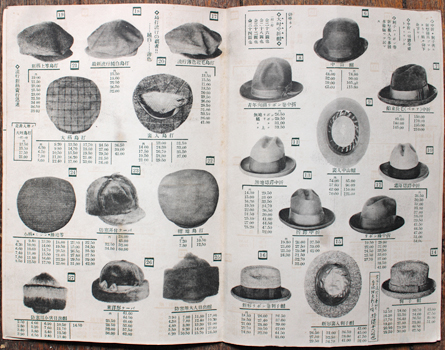
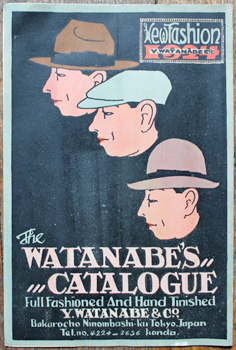
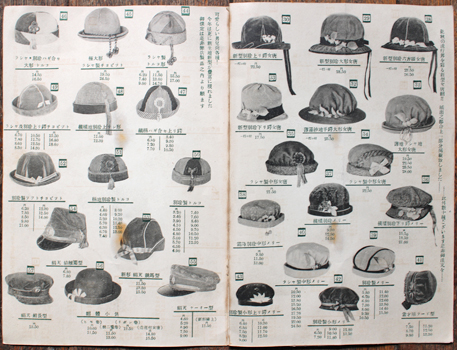
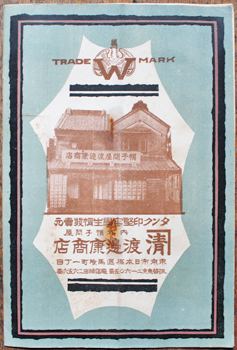

Catalogue - hats. Watanabe, Tokyo. The Watanabe's Catalogue : Full fashioned and hand finished. Y. Watanabe & Co., Nihonbashi, Tokyo, Japan. Tokyo, [1924]. 23x15cm colour illustrated publisher's wrapper; 6pp, profusely illustrated with photo illustrations. An old fold, small stains. Au$150
72 models of hats for men and women; not just women, mogas - modern girls - jazz age women. So, flappers and cool, sinister men; the stuff of dreams. Mention is made of the first anniversary of the 1923 earthquake but the "New Fashion 1924" on the front cover is an even better guide to its date.
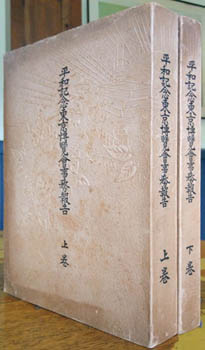

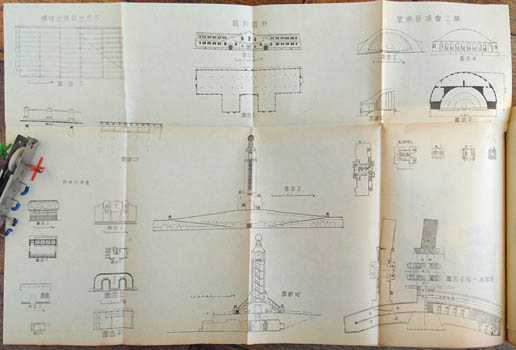
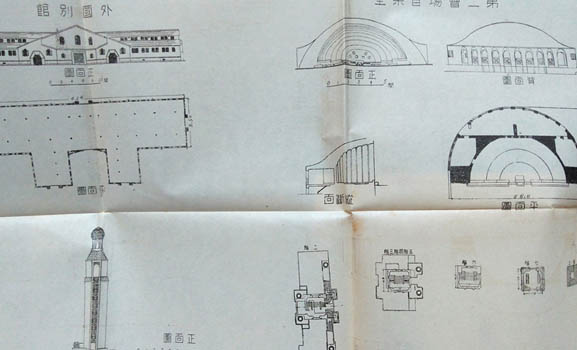

Exhibition - Tokyo 1922. [Heiwa Kinen Tokyo Hakurankai Jimu Hokoku]. Tokyo Fucho 1924 (Taisho 13). Two volumes 26x19cm, publisher's embossed wrappers (browned); 681pp, heaps of illustrations: folding colour plans, architectural elevations and plans, photo plates, etc. Browning and foxing expected from the paper but still a rather good fresh copy. Au$1350
The official report on the 1922 Tokyo Memorial Peace Exposition is the very model of what an official report on an exhibition should be. You could just about rebuild the whole thing from this. The detail extends to measured drawings of light fittings, plans of the garden beds and coloured reproductions of the tickets and advertising.
The 1922 Peace Memorial Exhibition, celebrating the League of Nations and a bright future, was the most lavish national Expo ever held. The pavilions were a mix of stately, ultra modern and funfair fairy tale.
  2 3 4 [5] 6 7 8 2 3 4 [5] 6 7 8   |